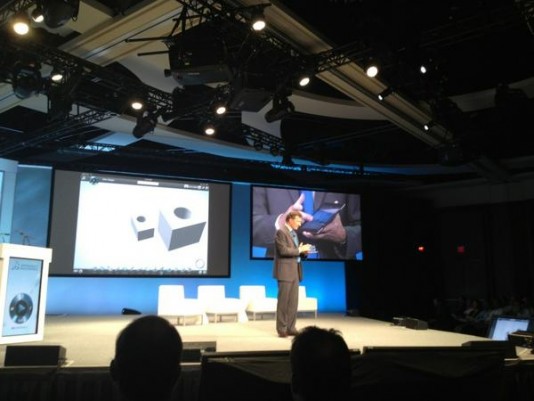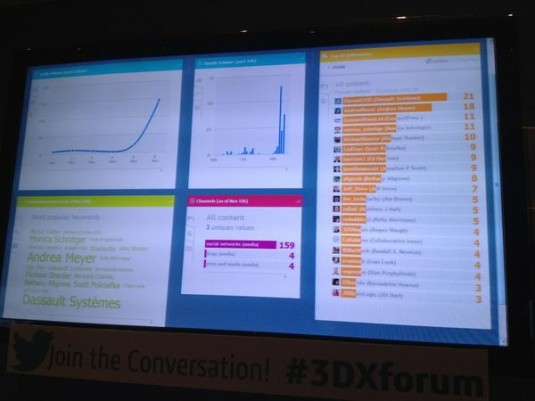PLM becomes one element in a larger plan to help enterprises compete in an experience economy. New Industry Solutions meld several Dassault products to create targeted applications.
When a software company invites an outside keynote speaker to the opening day of a customer conference, the goal is usually inspiration and entertainment before the serious stuff begins. Little did most of the attendees at today’s Dassault Systèmes 3DExperience Forum realize it, but while author Joseph Pine inspired and entertained, they were being set up for a barrage of visionary positioning from company executives.

Dassault Systèmes used the conference keynotes to launch its next ten-year agenda, an ambitious re-engineering of how products are designed, manufactured, and sold. CEO Bernard Charles and Executive Vice President Monica Menghini explained how Dassault will enable 3D experiences to transform how products are conceived, designed, and sold.
Having Joseph Pine warm up the audience was a good idea. He explained in succinct and witty style how commerce has moved over the years from selling commodities to goods to services and more recently to experiences. Since Dassault is pitching an “experiences” revolution to a product development audience, a firm foundation for the new ideas was important. Pine used coffee as the quintessential example. If you could buy green coffee beans directly at the price quoted at the commodity exchanges, a cup of coffee would cost a few pennies. Coffee companies buy it in bulk, roast it, grind it, package it and sell it as a consumer good, and now that cup of coffee costs the consumer 10 cents. If the beans go to Dunkin Donuts or McDonald’s, service is added to the price and the cup of coffee is 50 cents to $1 or so. Starbucks has turned delivering a cup of coffee into an experience, and charges $2-$5 for what is essentially a few pennies worth of beans. Go to the leading espresso shop in Venice and you can pay more than €15 euros—but the experience is said to be out of this world.
The trail Pine opened up to attendees was one of improving revenue, profits, and margins in any business by advancing levels of customization:
- Extract commodities
- Make goods
- Deliver services
- Stage experiences
Pine knew he was the warm-up act for Charles and Menghini, so he ventured beyond coffee or other examples of moving consumers up to the experiences market and talked about 3D. Being his own pitchman as well as the Dassault opening act, Pine says his newest book “Staging Infinite Possibilities” tells how the fundamentals of 3D reality—time, space, matter—can become the basis for building consumer and product experiences. In one infinite direction on a 3D axis, matter is the known universe and all material substance. Go in the opposite direction on that axis, and you get “no-matter,” or more accurately, digital substance. It is what we here at Jon Peddie Research like to call Digital Reality; building with bits as well as atoms. The axis for space is real places and locations on one side, “no-space” on the other—virtual places as in immersive environments for architecture or aero/auto design. Give the user a viewpoint impossible to achieve in the real world, whether it be at nano or planetary scale. Giving a doctor a 3D image of a beating heart viewable from any angle in real time is an example of no-space. The third axis of time is actual events in their sequence versus “no-time,” a realm of autonomous events. Dassault’s new app Paris 3D Saga is an example; click on a building or a neighborhood, and view it as it exists now or at any time in history. Being able to roll through the progression of a construction project as it was, as it is, and as it will be is an example of creating a “no-time” experience for the user.
Dassault CEO Charles helped explain the vision for 3D experience by going over what Dassault brought to market in the past. It started with 3D design, disruptive in its day. Next came 3D digital mock-up, and more recently 3D PLM. The logical progression, Charles says, is to move on to 3D experience.
What about PLM?
It was grandiose vision, and perhaps no one in product design loves spinning vision more than Bernard Charles. But in the foyer after the initial conference session, attendees were huddled in small groups trying to understand what they just heard. Snippets like “Is this a new product?” or “what does this mean for PLM?” could be heard.
More than once Menghini told her listeners, you can’t have an experience with PLM or PDM tools. It takes a platform of integrated software products all aligned to deliver experiential value; you must take all business processes into consideration. This idea of integrating software products to create an experience environment is behind the new Dassault initiative of delivering “industry solutions.” Today DS announced Winning Program, a new product for aerospace and defense customers. It takes the idea of a digital mock-up and accelerates it, by adding simulation and analytics, both visually and with dashboards. A&D companies bidding on new work can use Winning Program to manage proposals and conceptual designs. The goal is to have Winning Program guide A&D firms from conceptual design to an “authority to offer” status. The data comes from Catia, Enovia, Simulia, and perhaps Delmia or other Dassault products.

Menghini says Dassault’s new industry solutions are being created to provide 3D experiences that go beyond product development as it has been defined in the past. In the experience economy, Menghini says, you build value by bringing experience to the consumer. In the case of Winning Program, the experience is when the client sees can see simulations behind specific design criteria, or the possibility of drilling down on manufacturing costs during a proposal. Dassault intends to bring to market many such industry solutions in the coming months.
In a comment over lunch with some industry press and analysts, Charles let us see his cards a bit more clearly. What we did with Boeing in the 1990s, he said, we will do with other partners in other industries. What Dassault and Boeing accomplished in the 1990s revolutionized aerospace and automotive design.





